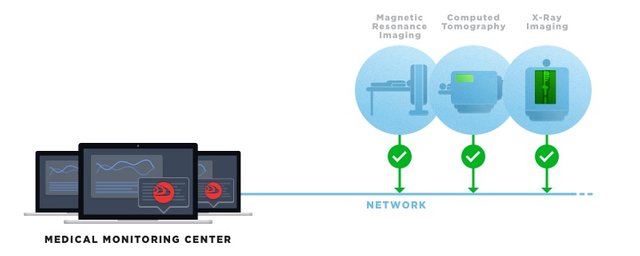How virtualization technology influences on healthcare industry
Computerization is having a major impact on modern medical systems and the healthcare industry as a whole. The focus of this article will be networking, where medical products are incorporated into pre-existing communication and data networks. This process, also referred to as biomedical device integration or device connectivity, is concerned with creating and maintaining a connection between an information system and a medical device. An example is a patient monitor connected to the patient’s Electronic Health Record (EHR).

The market for medical device connectivity is experiencing substantial growth. From an estimated $3.4 billion spent worldwide in 2012, according to Transparency Market Research, growth through 2019 is expected to approach 38%. The driving forces behind the adoption of biomedical device integration are improved quality of patient care combined with cost savings for the healthcare industry.
Impact on Manufacturers
Medical device manufacturers have had to modernize their products to capitalize on the demand for device connectivity and to keep their offerings relevant in a modern, computerized medical system. Medical technology manufacturers have to consider a number of issues when producing devices designed to be used in networked medical systems. Devices must integrate with Clinical Information Systems (CIS) in order to satisfy market trends and satisfy clinical requirements. This can be a complicated process that involves developing a framework for clinical documentation connectivity as well as encompassing design features that add to the device’s utility for healthcare professionals.
In addition to manufacturing concerns, other aspects of network-connected devices can be problematic when used in the healthcare industry. One of the primary challenges is adequately addressing concerns over security and privacy. Network connected devices are vulnerable to attacks from malware, hacking, and data theft. This is true in any industry, but the sensitive nature of medical information makes it especially important in the healthcare arena. Security protocols practiced throughout the IT world need to be built into medical devices. Combined with effective security education and the establishment of standards and regulations, security concerns with medical devices can be mitigated.
Impact on Clinicians
Automating and simplifying workflow is an attractive feature of biomedical device integration as it increases the value of the EMR (Electronic Medical Record) and its use by healthcare professionals. Connected patient monitors can send vital signs directly to the nurses' documentation system. This allows the clinician to quickly validate the data in the EMR before adding it to the patient’s record. Removing the manual data entry process reduces the risk of human error, and gives the clinician more time to focus on improving the overall care and safety of their patients.
Patient identification is one of the key factors in developing successful automation practices that employ device connectivity. The current manufacturing trend is to associate a biomedical device with a specific location. This can be a patient’s bed or room. Many devices can be moved easily at any time, so relying on location when integrating data into an EMR or CIS is not always a dependable method of identification. This poses a risk that patient data can inadvertently be stored in the wrong patient record. Healthcare facilities cannot tolerate this level of risk for obvious reasons.
To counteract this potential problem, technological solutions are being introduced to better manage the issue of patient identification. Two key identifiers are gaining traction and are currently in wide use. They are radio frequency identifiers and bar-code identification. Patient data is encoded with a bar-code that is part of the patient’s ID wristband.
In April 2013, HIMSS (Healthcare Information and Management Systems) stated that interoperability in healthcare depends on the ability of various information systems and software applications to communicate and act on the information that is exchanged. The goal is to have data exchange schemes and standards that allow sharing of data across the healthcare industry regardless of the particular application or vendor involved in the data transmission.
Interoperability refers to the facility of health information systems to interact both within and across organizational boundaries to advance the effectiveness of healthcare delivery to both individuals and communities. In order to further this goal, standards have been developed over the last several years. One of the main industry organizations striving to establish these standards is Continue Health Alliance. They are working toward a system of truly interoperable connected health solutions and standards for medical devices to ensure they can interact with the healthcare systems currently in place.
Medical device redirection technology integration
The developers at Eltima Software have designed a network solution that can be used to connect medical devices and monitors without the need for extra wires or cables. Eltima Port Virtualization Technology (EPVT) enables the establishment of serial communication between medical equipment in a way that it can be accessed and controlled remotely.
By simply integrating EPVT into a healthcare facility’s Clinical Information Systems, biomedical devices can be connected to the Internet. This allows the data to be transmitted to Internet-capable devices like a computer or MRI monitor.
EPVT offers stable connectivity and data transmission rate and securely protects the transmitted data. This outstanding tool is an optimal solution that enables patient monitoring, diagnosis, and treatment to be accomplished wirelessly.
EPVT is designed to provide medical devices with wireless communications while maintaining their level of performance. Integrating EPVT into a medical system allows:
- Enhancing the functionality of current medical center software by the addition of remote, wireless control of medical devices over the Internet.
- Simplifying the work of medical specialists through the ability to remotely access and program medical devices from any location.
- Lowering costs of medical equipment for healthcare providers by eliminating the need for cabling.
- Eltima Port Virtualization Technology supports all major operating systems and can easily be integrated with any type of serial hardware, such as a remote MRI, or software applications.